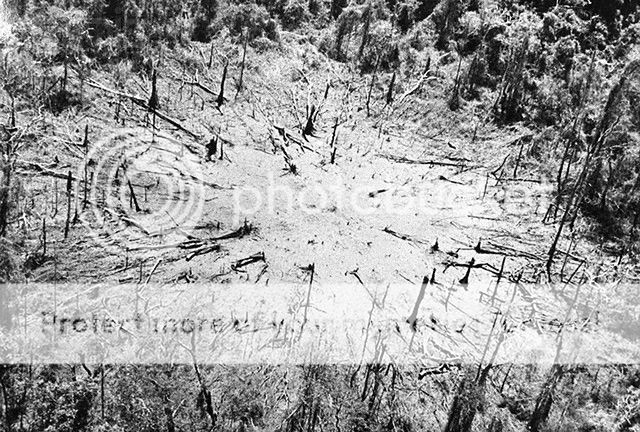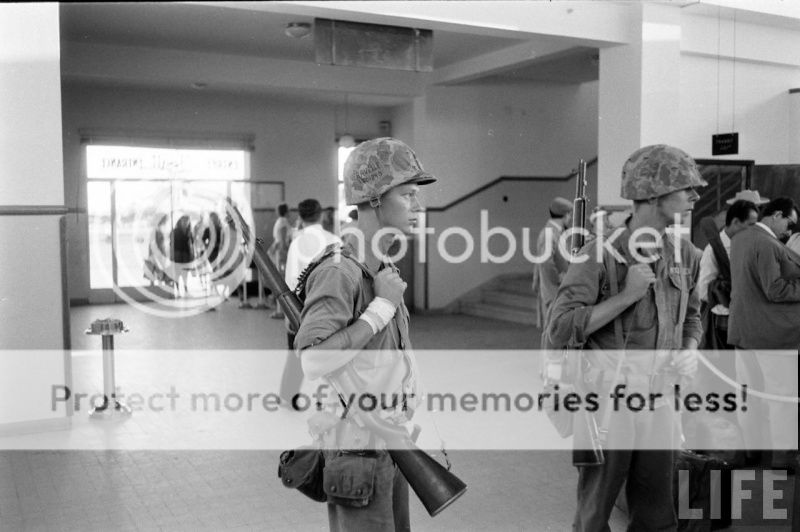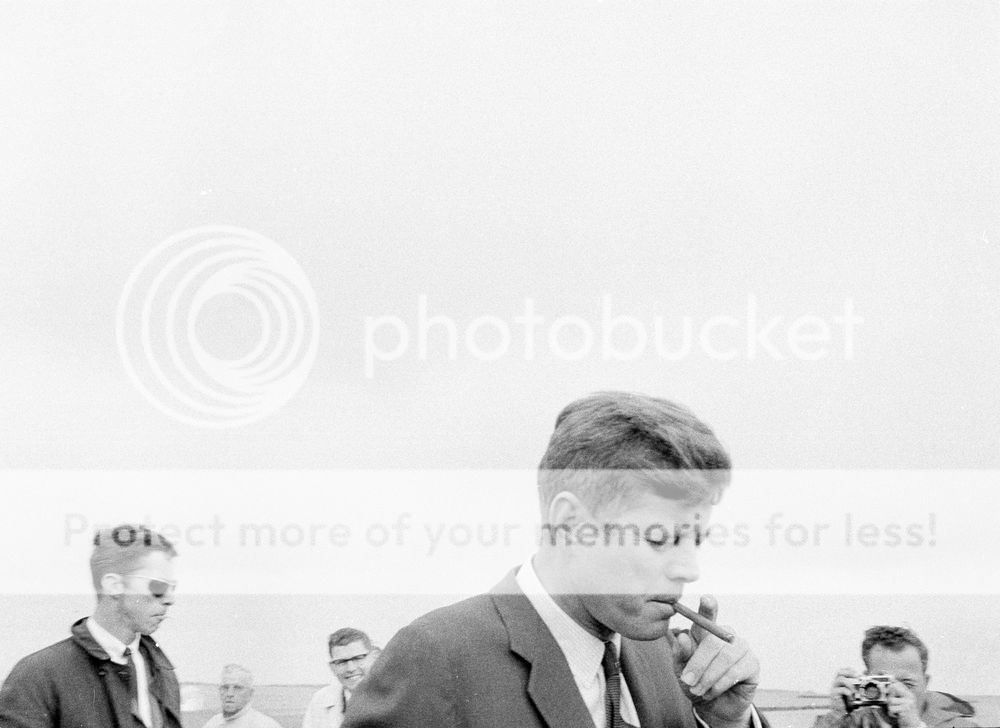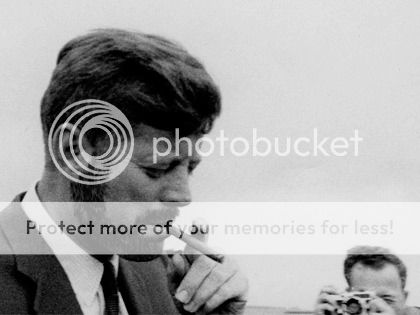The New Normalcy in Cuba – February 1963 to March 1963
After Guevara’s death in 1962, the rare pockets of resistance remaining in the fight moved further into the jungle with only one direction left to retreat in, down. Cuban communists, now so fractured they could not truly be said to be acting as a cohesive force, began digging simple tunnel networks under the jungle. They hoped to hide themselves and their dwindling munitions from the sights of American bombers and aerial reconnaissance flights. Examples of these tunnels were quickly discovered by American patrols and the reports supplied to Secretary Nitze greatly overestimated the true amount of forces and tunnels in Western Cuba. Operation Rough Rider II had already proven incredibly demoralizing to the shattered enemy, but this overestimation would lead Secretary Nitze to ramp up the conclusion of combat operations with a series of incredibly powerful and distinguished bangs.
Classified as the BLU-82, Nitze’s answer to what he called the ‘Stragglers’ was a new and experimental type of fuse that provided the unique ability to have maximum devastating effect in the blast radius with the added benefit leaving no blast crater of any kind. These 15,000 pound bombs were initially devised to create immediate landing zones in the dense Cuban jungle for troops hunting for RPRC camps, but this need had not proven strong enough to actually deploy any BLU-82’s into combat. Now fearing that these tunnels would allow a permanent entrenchment opportunity for the Communists, Nitze ordered 35 of these experimental weapons as a demoralizer.
Big-Blue's devastating wake - February 15th 1963
‘Big Blue’, the first of these weapons to be dropped on Cuba was piloted over its drop zone by a Sikorsky CH-54 and dropped into the jungle. The explosion was so powerful that all surrounding oxygen of the blast radius was sucked towards the flame before a shockwave broke and crippled trees in an epic show of firepower for 3000 feet. Between February 15th and February 23rd all 35 of these bombs were dropped in densely forested areas that had most recently reported enemy activity. Along with these monstrously large bombs were constant volleys of napalm that brought areas of the Western Cuban jungle into a hellfire of biblical proportions. The straggling Communist holdouts officially surrendered during the week of March 4th, finally bringing an end to official American combat operations in Cuba.
“My Fellow Americans, I have the great happiness to report to you in this hour that the American mission in Cuba has been accomplished. The last remaining Communist forces on the island have surrendered and I have spoken to Cuban President Cardona on our intentions going forward. In this collective victory with the Cuban people we have shown the power that Freedom brings and we will show what happiness freedom is capable of to the peoples of our Southern neighbor. US armed forces will begin a gradual and layered withdrawal from Cuba with 80% of those deployed expected to leave positions in Cuba by the end of June. Those remaining forces will act in a policing and non-combative role in order to ensure that the government of Cuba is peacefully able to solidify and begin recovering from the damages brought on by the Castro regime. I have granted the Army Corps of Engineers with the task of rebuilding numerous bridges and roadways that will prove vital to the recovering Cuban economy. These projects will of course be under guard by both US and Cuban forces for the time being. In the coming weeks this Administration will be appointing an official Ambassador to Cuba to work hand in hand with the Cardona government……
Thank you, and God Bless.” – Excerpt from Richard Nixon’s Cuban Victory Address.
The once crowded military that had grown up around Guantanamo Bay steadily began to replace American soldiers with Cuban refugees as combat operations came to a stop over the next few months. Skies previously filled with bombers and jets became replaced with supply helicopters and reconnaissance flights. Across major Cuban cities that had been the sights of the fiercest fighting since the Korean War soldiers and engineers were now helping remove the rubble they had created. American cargo planes peppered the outskirts of villages and cities with supply drops of MREs and clean drinking water; each crate adorned with the new Cuban flag to build support for the Cardona government.
US Troops trading daily patrols for the 'relaxing' life of guard duty in a Cuban governmental building - April 1963
The new American role in Cuba was one of peacekeeper during the solidification of the Cardona government. While the Nixon Administration wanted to begin pulling out as many soldiers as it could in order to begin curving back costs that Rough Rider II had demanded, it was also aware that any potential risk against Cardona could not be ignored. For the sake of ensuring the transition to freedom, curfews and regional passports were temporarily issued to limit the movements of individuals throughout the country. For good or worse, the Cardona government, in desperate need of military officers turned toward the tamer survivors from the days of Batista, a move among many that was kept quiet when no official papers or news sources were restarted. The movement of the house of government from Trinidad back to Havana was also begun so to give Cardona more of a claim to power to the people who had always known Havana to hold the seat of power.
“We now begin a new era for Cuba, where freedoms will be upheld and not curtailed. This will be the time where we look back and remember heading with open arms toward a new normalcy” – Secretary of State Milton Eisenhower, March 24th 1963
Faced with yet another selection for whom to appoint to a position, Nixon turned to a former friend that had become a bitter opponent as his most preferred choice to act as the voice of America to the Cuban government. Senator John Fitzgerald Kennedy.
Conversation between President Nixon and Senator Kennedy: March 28th 1963
Kennedy: Hello, this is Senator Kennedy.
Woods: Senator Kennedy I have a call for you from the President.
Kennedy: Thank you.
Nixon: Jack how are you.
Kennedy: Fine all things considered, what can I help you with Mr. President.
Nixon: Well Jack, I’ve had my men put together a short list for me… to select an Ambassador to Cuba, you know to oversee the whole process down there and be a face for the country.
Kennedy: Alright…
Nixon: And Jack, you see… I’ve hated every name they’ve brought to me. None of them are really what I’m looking for and I’m wanting to bring a Democrat in on this, someone who won’t mind telling me if something isn’t going right down there.
Kennedy: And you want my opinion on who to select then Mr. President?
Nixon: In some ways, yes. Jack, I’d like you to go…
Kennedy: I’m not interested…
Nixon: Now, Now, Now… here me out Jack. Look, I’ve helped you and now I need you to help me with this, some would kill to go down to a place like Cuba, especially once everything is running smoothly again.
Kennedy: What do you mean you’ve helped me?
Nixon: That’s not what I’m trying to focus on here Jack, look… I can’t go down there myself to oversee it or I’d be doing that right now. I need someone I can trust to run a tight ship but also not say something just because I want to hear it. We both know you’ve always had a knack for foreign relations.
Kennedy: How did you help? What did you mean?
Nixon: I pulled Hoover’s chain while he was frothing at the mouth for a kill. He had information on whatever it is going on between you and Jackie. And I told him that I wanted it buried, that I didn’t want him ever bringing that up to me again. I wanted it disappeared. So far it has stayed disappeared despite his best wishes. Look I didn’t mean to mention it, don’t let that crowd your judgement here.
Kennedy: If you think that… that you can use that to influence my decision on this Mr. President…
Nixon: Jack, I wouldn’t dream of using something like that against you. I didn’t in the election and I’m not now, your Vice President pick did more to try and kill you in the primaries than I ever did in the election. You know that for a fact. I really do need your expertise here. If anything, try and get Jackie to come with you… get the house back in order and everything. Get away from Washington and let that do you some good. I’ve never had any harsh feelings on anything said between us and I hope you’ve felt the same on that.
Kennedy: Let me consider it Mr. President… I will get you an answer.
Ambassador Kennedy arrives in Cuba - September 1963



